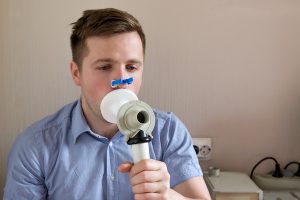What is spirometry and why is it important for asthma management?
Spirometry is a breathing test that helps doctors figure out if someone has asthma.
Here’s how it works:
1. Checking How Well Your Lungs Work: Spirometry measures different things about how you breathe, like how much air you can push out in one second (FEV1) and your total lung capacity (FVC). These numbers give your allergist a baseline to see if your lungs are working as they should.
2. Seeing How Your Lungs React: During the test, you might be asked to inhale a medicine called a bronchodilator (also known as Albuterol). If your breathing gets significantly better afterward, it suggests your airways are sensitive, which is common in asthma.
3. Spotting Breathing Problems: Asthma can make it hard to exhale air from your lungs because of inflammation and mucus buildup. Spirometry can catch these problems by showing if your FEV1 and the ratio between FEV1 and FVC are lower than normal.
4. Tracking Changes Over Time: Asthma symptoms can come and go, so spirometry helps track these changes by comparing your lung function at different times. This helps your allergist confirm if asthma is the cause of your breathing issues and keeps an eye on how it’s affecting you.
In simple terms, spirometry helps your allergist understand how well your lungs are working, find out if asthma might be causing your symptoms, and track any changes over time to make sure you’re getting the right treatment.

What can I expect during a spirometry test?
The test is done right in the office during your visit. It takes from 5 to 15 minutes. During the test, you’ll be asked to take a deep breath and then exhale as hard and fast as you can into a mouthpiece connected to a spirometer. You may need to repeat the maneuver several times to ensure accurate measurements. The test is painless but requires effort and cooperation to obtain reliable results. Most children ages 6 years and older, as well as adults, can do the test easily. Your allergist or a trained technician will guide you through the process and explain the results afterward, including any implications for your asthma management.
